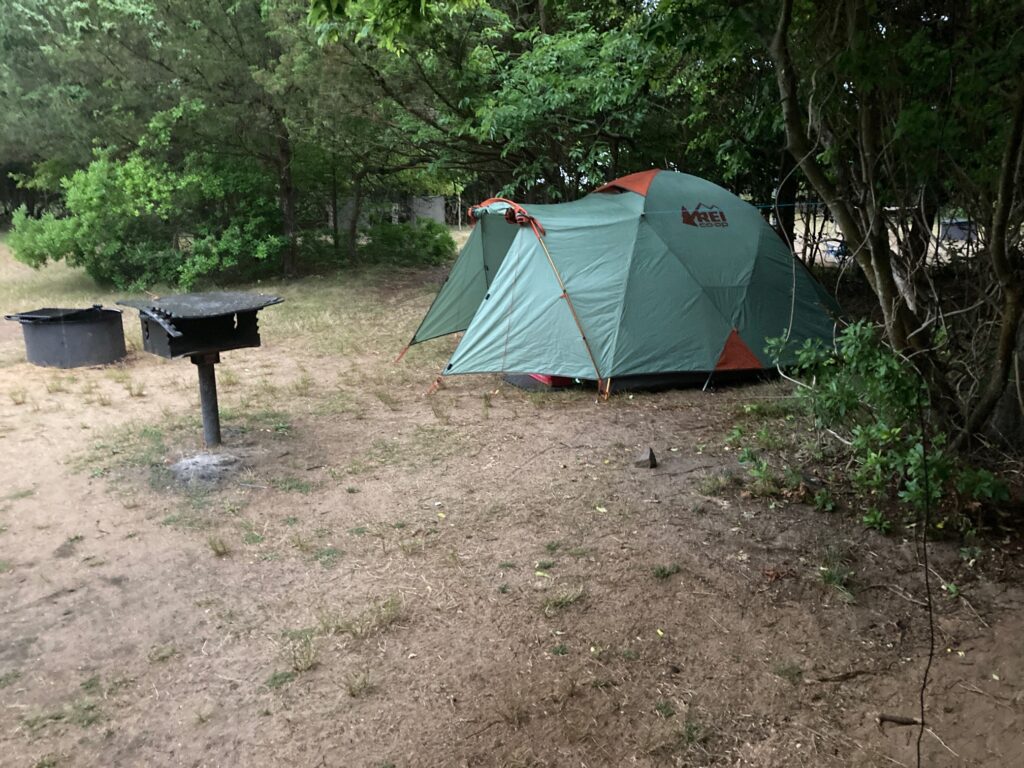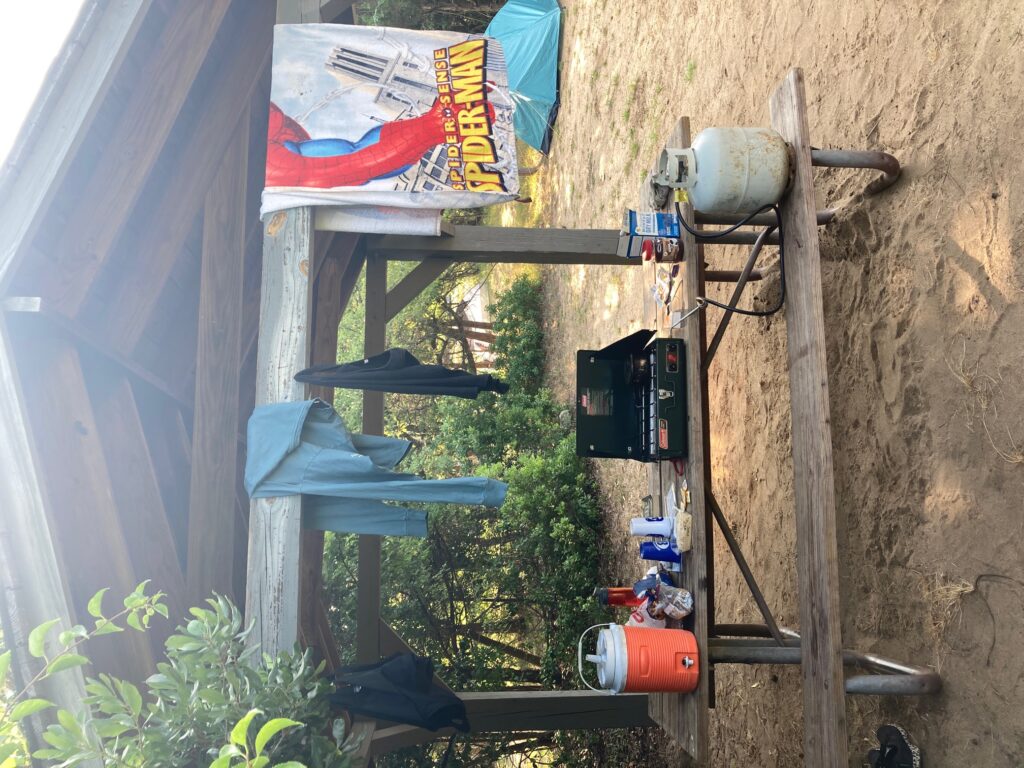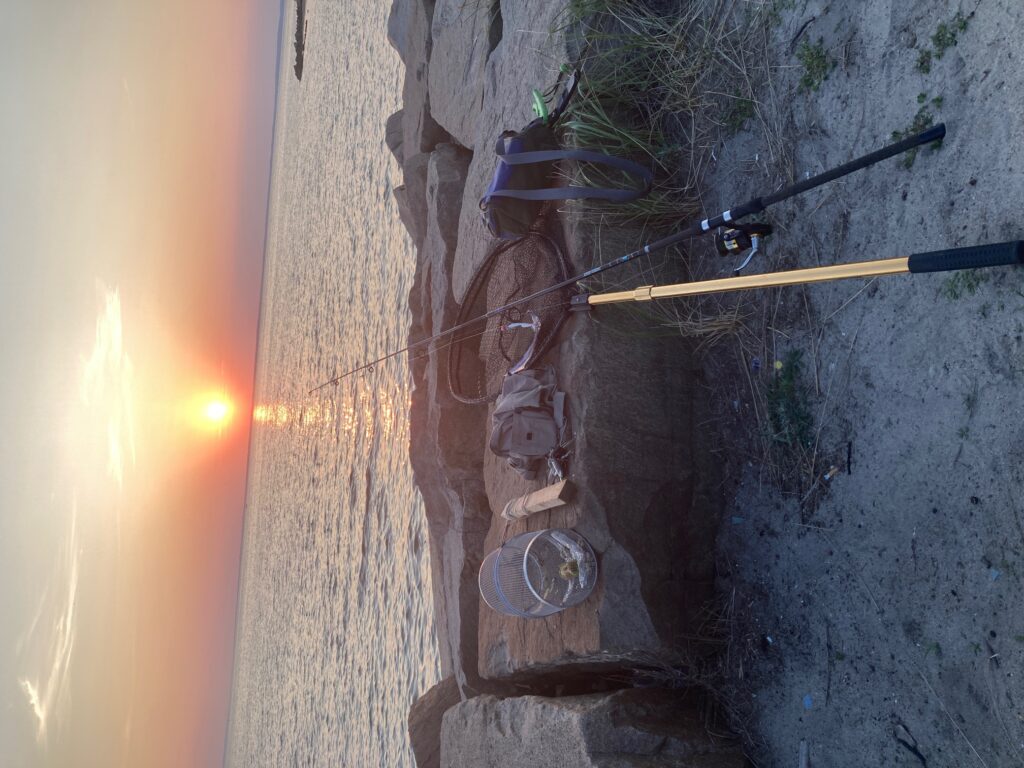Posts Tagged → raccoon
Midsummer report
My apologies for the long absence here. Summer is in full swing and our family has been operating at full tilt speed. Time only for doing things, and none for writing about it all, until now.
First off, our oldest kid was married on Independence Day. Held at a pretty and historic farm, it was a fantastic wedding, and we feel like we acquired a wonderful addition to our family. However, the preparation necessary for that event took up a lot of time and energy, for many months. And then there was the recovery week. And then there was the vacation week. Hence no blog posts. Full credit to my wife for all of the wedding planning.
At least I myself am back in the saddle, while other people around me are still recovering from their vacation. Not everyone does well with the surf fishing bum lifestyle, including sleeping on the beach, eating questionable food from a warm cooler that has been pawed over and drooled on by feral raccoons, and drinking fetid water. I myself thrive in this kind of environment, and so I am back to report back to our three readers.
What can I say about the wedding other than I fired our small black powder cannon seven times, for good luck. It was Independence Day, and while the venue does not allow fireworks, they did allow the cannon (it’s a cast iron, steel sleeved replica swivel gun with a 1.75″ bore). And in my speech as the bride’s father, how could I miss an opportunity to point out that Independence Day was brought to us by citizens with guns? That is a fact, is it not?
And (of course, I guess) I heard back afterwards that some of our wedding guests were offended by the cannon and also offended by my mention of the origins of American freedom – citizens with guns. You can’t make this stuff up if you tried, like it’s a Hollywood movie script caricature of spoiled rotten children who get everything that Planet Earth can provide and yet nonetheless complain about it. Something like “The food here is terrible and the portions are so small.”
Are Americans now really offended by Independence Day fireworks? Are they offended by displays of patriotism and mentioning of historical facts that unfortunately run contrary to some evil political narratives that privately owned guns are bad and our freedom was brought to Americans by a immaculately conceived federal government that descended from Heaven? Are some wedding guests now so crass that they actually complain about the bride’s father setting off his celebratory toy cannon for the enjoyment of all the normal fun-loving people in attendance?
I have a hard time believing these things, but I did get to witness this stuff. America is in big trouble when its own citizens, young and old, hate its founding and can’t give a proud father his one moment and some space to celebrate it. Jiminy crickets.
Just returned from a subsequent beach trip to a a long spit of federally managed property on the east coast. The National Park Service rangers were 99% normal, nice, intelligent Americans, thank you very much, Gage, Donald, and Stephen.
In this national park there is a problem with artificially high numbers of deer, foxes, and racoons. They have no natural predators and they are multiplying at breakneck rates and having huge negative impacts on the environment and local ecology. Vegetation shows a distinct deer browse line about four feet above the ground, and the racoons are everywhere, aggressive, and aiming to ruin your trip. I watched a red fox steal a camper’s breakfast sausage meal right off of his plate on the guy’s picnic table. We had raccoons patrolling our campsite and under our table as soon as we broke out our food. They will grab your food right out of your hand. It is a fact that raccoons are host to some nasty parasites they excrete in their poop, which was abundantly displayed all around the campsites. Raccoons are also the number one vector for rabies among wildlife.
Aside from posing health threats and incessantly badgering the humans who are trying to enjoy the park, the foxes and raccoons also eat the eggs of rare nesting shore birds. These rare birds enjoy huge swaths of cordoned off human-free dunes and beaches in the park (and also on federal and state lands out on Long Island, like Orient Point and Montauk). And yet the same exact NPS staff enforcing the human no-go dune zones policy are absolutely fine with the overabundant nest-raiding foxes and raccoons that render all the no-go zones meaningless. The staff do not support hunting or trapping these destructive pests, either to improve the park visitor experience or to protect the natural environment.
How can the rare birds successfully nest on the ground and hatch their chicks there when the artificially super overabundant egg-eating raccoons and foxes are allowed to roam at will?
Talking with various National Park Service staff about this problem resulted in exposure to various levels of education and serious/unserious mindset. Most of the NPS staff acknowledged there is a wildlife problem on site that must be addressed. Hunting the deer and trapping the foxes and raccoons is the normal and responsible way to deal with this artificial human-caused environmental problem. These are the responsible and serious ways of addressing a visitor problem on land that is owned by the US taxpayer and whose management is entrusted to taxpayer-paid bureaucrats.
However, when I mentioned the above normal solutions to a young, handsome, tall NPS Park Policeman patrolling our campground, he responded “The same can be said about humans — there are just too many humans. And your solution to the overabundant raccoon problem is not humane.” He would get rid of the humans and allow the artificially high numbers of nuisance wildlife to proliferate. With taxpayer-paid federal employees of this guy’s low caliber and high wokeness quotient, the park visitor experience is going to degrade. C’mon, NPS, you can screen your employee applicants better than this. This foolish people-hating young guy should never have a gun and a badge, much less wear an NPS uniform.
Overall the surf fishing was fun if mostly unproductive. Probably due to the high heat and ferocious sunshine. I can report that catching cownose/ bullnose rays on strong surf tackle is a hoot, but then safely decoupling that animal from the tackle is a whole other thing. They whip their barbed tails around trying to nail the fisherman, who is trying to release them back into the ocean (I learned to place something heavy on the tail while using heavy pliers to remove or break off the hook). We did witness a large shark violently feeding close to shore, and it would be a fair guess to say it was probably eating these rays, which we caught and saw in abundance on both the bay side and the ocean surf side.
So that is the mid-summer report. Fast action, lots of family, some big family celebration and lots of family movement across the beautiful American landscape for work and vacation. I hope that you the reader are also enjoying your summertime. Summer is such a glorious time to be with family and friends, to visit new places, to camp out under the stars and cook over an open fire, to think through life’s normal challenges and to spend time with people we love…and then it is over just when we are all starting to really get into it.
So make the most of your summer.
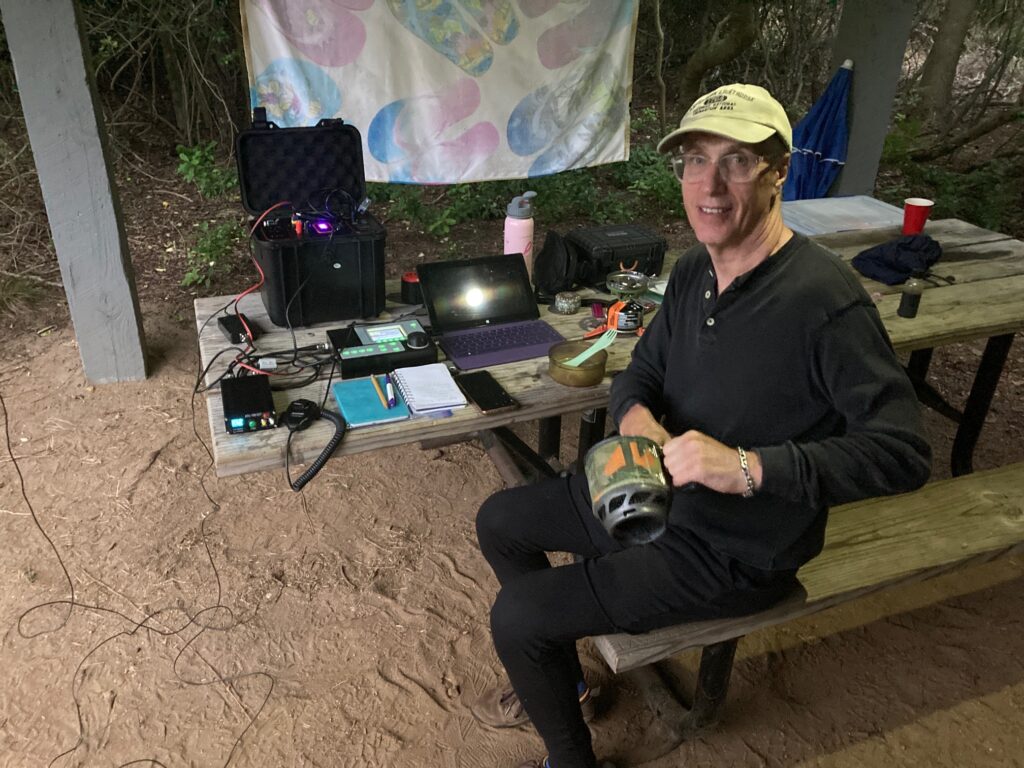
Campsite neighbor Steve, a PhD engineer ex-patriot Brit and defiant leftist, helped MAGA Maniac Josh fix my malfunctioning headlamp, demonstrating that it’s easy to be enemies when separated by keyboards and easy to be friends when living side by side
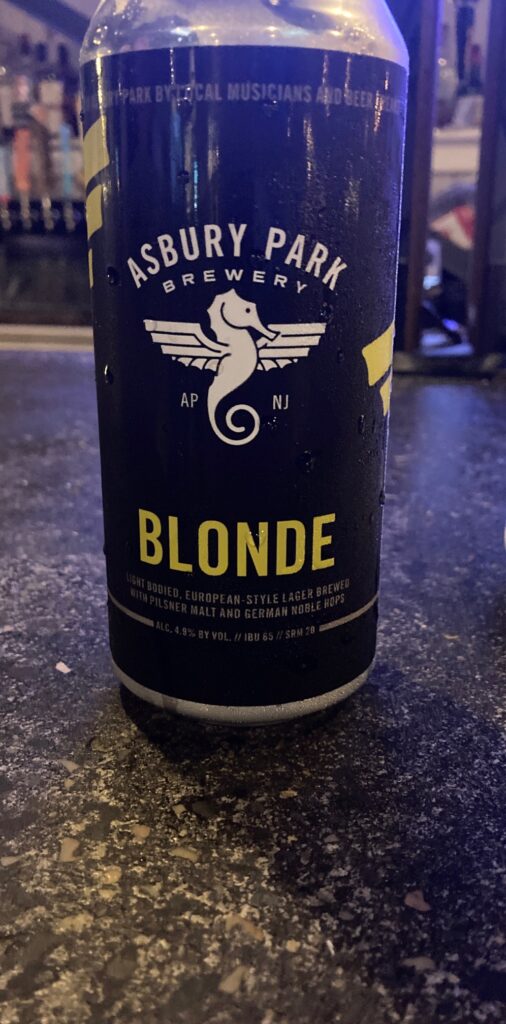
Asbury Park Brewery is a local flavor that I was happy to support. No sign anywhere of Bud Lite or Budweiser anything, thankfully

Symbol of foolish National Park Service policies seeking to protect rare shore birds by excluding people from their habitat, but allowing artificially overabundant populations of nest-raiding raccoons and foxes to roam at will.
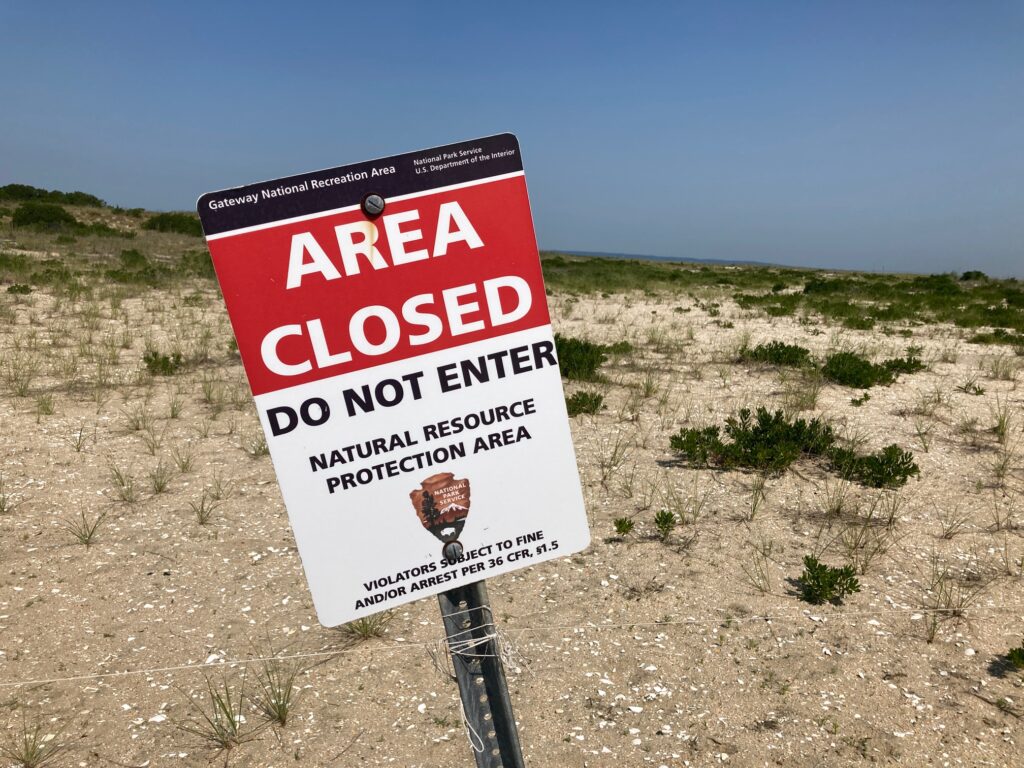
Beach goers nonetheless entered this area because there were zero nesting birds in it and there were literally tons of foxes running around in it. Come on National Park Service, you can do much smarter than this
Why I Trap
Trapping wild animals for food, fur, and pest control is as old as the human race, tens of thousands of years in action.
The traps may have changed over time, but the purposes have not. Pests still ruin valuable crops, eat valuable farm animals, and break into homes and ruin stored food. Humans still prefer to eat wild meat, which is tastier, cleaner, and healthier than agribusiness meat. And humans still prefer to wear wild furs that are warmer, prettier, and more natural than human-made fabrics. That furs are renewable, sustainable, biodegradable, and natural adds to their appeal.
But what has also happened over time is the incredibly abundant material success of Western civilization has created an unnatural gap between consumers of food and goods, and the natural world of forestry, farming, and natural resource management that creates those very same consumer goods.
Frankly, Americans and Europeans are largely spoiled. Nearly everything we need is easily obtainable. Very few of us have to work hard for food, or shelter, the necessities that keep most humans personally toiling in dirty agriculture daily around the globe. Even our poor have expensive personal items like TVs and phones.
Never will I forget a family member decrying “those evil power companies,” years ago, because she did not like the air pollution resulting from power generation. It did not occur to her that her role as a consumer and generous user of electric power made her the real driver behind electricity generation, as well as all of the associated processes branching out from it.
And similarly, the ease of “shopping” for an unimaginably rich and diverse array of food items, so many made to suit nuanced tastes, especially meats, has resulted in a populace that does not understand the basics of what it takes to put meat and food on those same supermarket shelves.
Enter trapping. At first glance to the average American it appears to involve the sadistic mistreatment of very cute, furry animals that would beg us for their lives in humorous dialects of English, if we would only let them. Silly depiction, yes, but opposition to trapping is even more silly than imaginary talking cartoon animals.
Here are some reasons why I trap: We find a mother turtle, attempting to lay another clutch of eggs along the rail trail, the loose pea gravel of which provides perfect conditions for holding, incubating, and hatching turtle eggs. Three feet away is her previous nest, torn up, with raccoon tracks all over the destroyed turtle eggs, eaten by the raccoon. Raccoons are abundantly dead along roadsides everywhere because they are artificially overabundant in the wild, and especially in suburbia, where they have no real predators other than random cars. There are too damned many raccoons, and they are having a disproportionately high impact on other animals, like turtles, nearly all of which are in decline across the world.
Another reason: The PA Game Commission and many other wildlife agencies nationwide are studying why whippoorwills are in such steep decline. One of the reasons is they are ground nesting birds, which makes their nests easy prey for the raccoons, possums, and skunks that pulse out in unnaturally high numbers from the habitat created for them in suburban sprawl environments. The one place I have seen and listened to these sweet nocturnal birds is a place where we aggressively trap, thinning out the artificially high population of ground mammals that would otherwise raid the whippoorwill nests. We create breathing room for the birds to nest and rear young. The same holds true for grouse, turkeys, and woodcock, all ground nesting birds.
I could go on with a long list of cute feathered and furry animals that are in trouble because of predation by skunks, raccoons, and possums, but it should not be necessary. I prefer these animals because they are colorful, or sweet, or rare. Some of these animals are in real trouble, and if not for trapping of their predators, they might be gone altogether. Any thinking person will join me in preferring these uncommon birds and animals over the overabundant, artificially common racoon, possum, or skunk.
Given that choice, trapping is the natural way to preserve animals we want. We remove the animals we don’t want. I trap because I love wildlife, and given certain population dynamics, as a Nature lover, I face certain natural tradeoffs that I must consider. In order to love and enjoy one little birdy, I must eliminate a whole bunch of its predators.
What amazes me is how little most people know or want to know about trapping. They write it off with the wave of a hand. They seem unimpressed that we can easily target certain types of animals, and thereby avoid other kinds of animals in our traps. We can selectively harvest overabundant predators, to help cute, little, rare and endangered critters.
Trapping is not random, it is not haphazard, it is not cruel, and for me it is not about money. For those of us who love Nature and all in it, trapping is really the only way to ensure that Nature in all her facets sticks around. That, or level all of the large lot suburban sprawl developments and pack everyone into cities.
After all, it is suburban back yards that give us the worst of the critters needing the most control: Raccoons, possums, and skunks.
A Murder of Crows
My two greatest thrills in the outdoors are native wildflowers, like the trilliums and pink ladyslippers, and native birds, like grouse, turkey, woodcock, wood ducks, and various migratory songbirds.
All of these flowers and birds are under pressure under the best of circumstances, and in many places they are succumbing to that pressure because of artificial factors.
Native wildflowers are naturally browsed by deer, and increasingly collected by people who sell rare plants (and animals). If deer herds are balanced with the carrying capacity of the landscape and surrounding habitat, then the plant colonies can sustain the browsing. The collecting is usually illegal, involving sneaky trespass on private property and violating state law and regulation when done on public land. It is totally unsustainable.
When it comes to my favorite birds, the usual pressures of predation or hunting are hardly a factor in their population success. What is a growing factor is the impact of ground mammals on ground nesting birds, including all of my favorites above and others like more common ducks.
Ground mammals like raccoons, possums, skunks, fox and coyote have a natural place in the natural world, but humans have so greatly altered that natural world that some of these animal populations are disproportionately growing and having disproportionate impacts on other wildlife.
Exhibit A is low density suburban sprawl type residential home development, relatively large home lots in the one to five -acre range.
Low-density suburban sprawl residential development is now the ground zero for artificially high numbers of skunks, possums, and raccoons. Sprawl development provides perfect backyard habitat for these predators to breed and den, but these back yards are too small to hunt or trap effectively or legally. So these burgeoning and unchecked predator populations keep pulsing out into surrounding farmland and forest. In those more stable habitats, these artificially high predator numbers wreak havoc on the other species who live there, notably my favorite birds, which happen to be ground nesters.
Ground nesting birds are highly susceptible to nest disturbance and egg loss when they are surrounded by artificially high populations of skunks, raccoons, and possums. In many areas ground nesting birds are experiencing dramatic population declines because they simply cannot nest long enough to hatch a brood of chicks, or the chicks cannot survive predation long enough to develop flight, so they can escape from otherwise slow moving predators like skunks and possums. Adding to the challenge for ground nesting birds is the dearth of brush and young forest which provide the best places to hide a nest on the ground. Most farms today are devoid of brush, and “select cut” high-grade logging has ruined most private forests, while anti-conservation activists decry aggressive forest management on public lands. Brush and young forests are nearly a rarity today, despite serving as nature’s best habitat.
Yesterday I got into one of those internet debates most normal people avoid. It centered on allegedly real photos of a flying mature eagle with a talon stuck in a foothold trap, posted on Lancaster Online. Lancaster Online is run by politically partisan legacy media staff, and it is a huge source of fake news and alternate facts. So when I saw there the photo of a completely closed foot hold trap, with not even a tiny jaw spread to accommodate the eagle’s foot, it looked like yet more fake news and I posted comments.
As you might imagine, a murder of crows of sorts descended upon the article, and upon me, and upon any other poster who either questioned the facts as presented in the article, or who promoted trapping.
Crows are natural enemies of eagles and other raptors. Crows are huge nest raiders, eating baby bird chicks whole right out of the nest. In the context of the Lancaster Online article, the crows took human form: Animal rights promoters, PETA advocates, anti-trapping and anti-conservation voices.
Like with a surrounding pack of crows (called a “murder”) wildly harassing a lone eagle in a tree, the loudly hysterical anti-trapping commenters immediately invoked emotional appeals, personal attacks, lies, advocacy for trespassing, leash-less dogs, and private property theft and destruction. None of them made any sense. None were based on fact, though it is true that occasionally an animal in a trap gets hurt (never mind that every single one of those hypocritical commenters has a direct hand in wildlife death and destruction).
I responded frequently there, and was answered by a surrounding murder of crows, loudly cawing, squawking, screaming, wildly flapping their wings and leaping from tree to tree. Pretty funny to watch, because not one commenter there debated wildlife biology, habitat, etc. Only emotional appeals mostly based on lies and fake news were presented. Lots of hysteria, not much reasoning.
And that right there is why I trap, dear reader.
There are too damned many cantankerous crows, skunks, possums and raccoons eating all of the really cool, cute, useful little birds I enjoy so much. I haven’t sold a pelt since I was a kid. Instead, today I trap to thin out the populations of the destructive ground predators so that the defenseless animals they eat have at least a sitting chance.
As for the eagle photographed flying around Lancaster County with its talon caught in the foothold trap, I have pledged fifty dollars toward its rehabilitation, if it is caught alive. And I want to personally inspect the trap rig, because what is seen in the photos makes no sense. One commenter, a trapper, noted it appeared to be an illegal trap specifically set to catch a raptor, like the eagle, in which case this subject isn’t about trapping, it is about illegal wildlife poaching.
But you’d never know that from the deafening screaming and cawing and flapping from the uncaring, unthinking, hostile, mob-like murder of crows.
UPDATE: 2/8/17 4:30 pm “Just received a call from PGC Director Matt Hough. Matt informed me that the eagle/trap incident was a true event. Fortunately, PA Game Commission officers were able to capture the eagle and remove the trap. There was no damage to the talon. The eagle was released and flew away with no impairment as a result of the incident. Matt did not have any information as to the individual responsible for the trap,” from an email sent to me this afternoon.
Last day of Great American Outdoor Show
If you have not yet gone to the new Great American Outdoor Show, today’s the day.
Even if you’re not a hunter, there’s still much to see and do. The Farm Show complex is enormous and every hall is packed. RVs, campers, boats, fishing everything, mapping, GPS technology, clothing. Etc.
One thing I noticed last week was a booth full of furs also selling turtle shells. Whether or not these shells are from wild native turtles, illegal, or from some farmed non-native species, it disturbed me to see them. Turtles take a good ten years to reach maturity, when they can begin breeding. Their nests are subject to raids by raccoons, skunks, snakes, possums, and bears. ATVs and dirt bikes often are ridden over the soft soils turtles choose to lay their eggs. Collectors grab them for illegal sales, dads take them home for their kids to see, etc.
You get the picture. Turtles don’t have it easy.
If there’s one thing missing from the GAOS, it’s an emphasis on land, water, and wildlife conservation. Plenty of emphasis on the taking part, not much on the conserving part. Maybe that’ll change at next year’s show.
